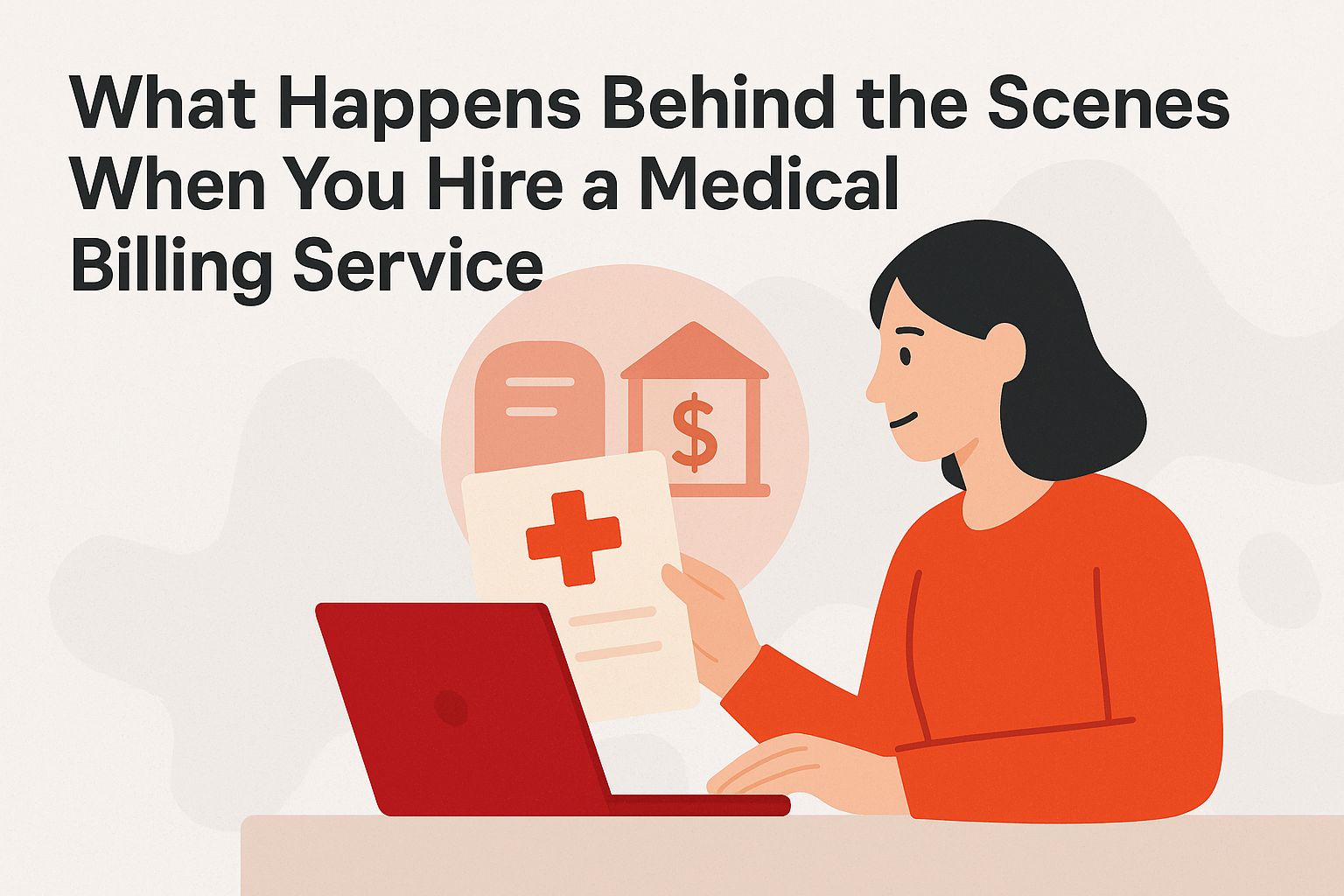
What Happens Behind the Scenes When You Hire a Medical Billing Service
Have you considered what occurs after you send off your medical billing? Each claim goes through a careful process to keep your practice operating without issues. Knowing this process is important because it affects your income and how you treat patients. You’ll learn how to recognize what you need, assess services, and go through the onboarding process. Dive in to see what truly goes on behind the curtain when you hire a medical billing service!
Definition of Medical Billing Services and Healthcare Revenue Cycle
Medical billing services refer to the administrative tasks of submitting and following up on claims with health insurance companies to receive payment reconciliation for healthcare services.
These services include important tasks like sending claims, billing patients, patient follow-up, and managing the process of income collection and accounts receivable.
For successful claims submission, use software like AdvancedMD or Athenahealth, which handle the filing process and reduce mistakes. Patient invoicing can become more efficient with tools like QuickBooks or Medical Office Online, which allow for fast billing and payment collection.
Revenue cycle management helps improve cash flow by checking accounts receivable regularly and using methods to decrease unpaid claims. As mentioned in our detailed guide on how medical billing services can improve revenue cycle management, efficient handling of these tasks can lead to better financial outcomes.
These services help you work more efficiently, raise your earnings, and grow your income.
Importance of Medical Billing in Healthcare
Good medical billing is important because it affects healthcare providers’ finances. It plays a key role in managing income and how smoothly the organization runs.
Correct medical billing leads to quick payments from insurance companies and reduces rejected claims. Healthcare providers can improve this process by using billing software like AdvancedMD or Athenahealth, which simplifies claim submissions and monitors payment statuses. Worth exploring: The Role of Medical Billing Services in Reducing Billing Errors
Regular staff training on coding updates and reimbursement policies can improve accuracy. Efficient billing practices do more than just improve financial results. They make patients happier by cutting down on billing errors and making fees transparent, which strengthens trust and keeps patients coming back.
The Hiring Process
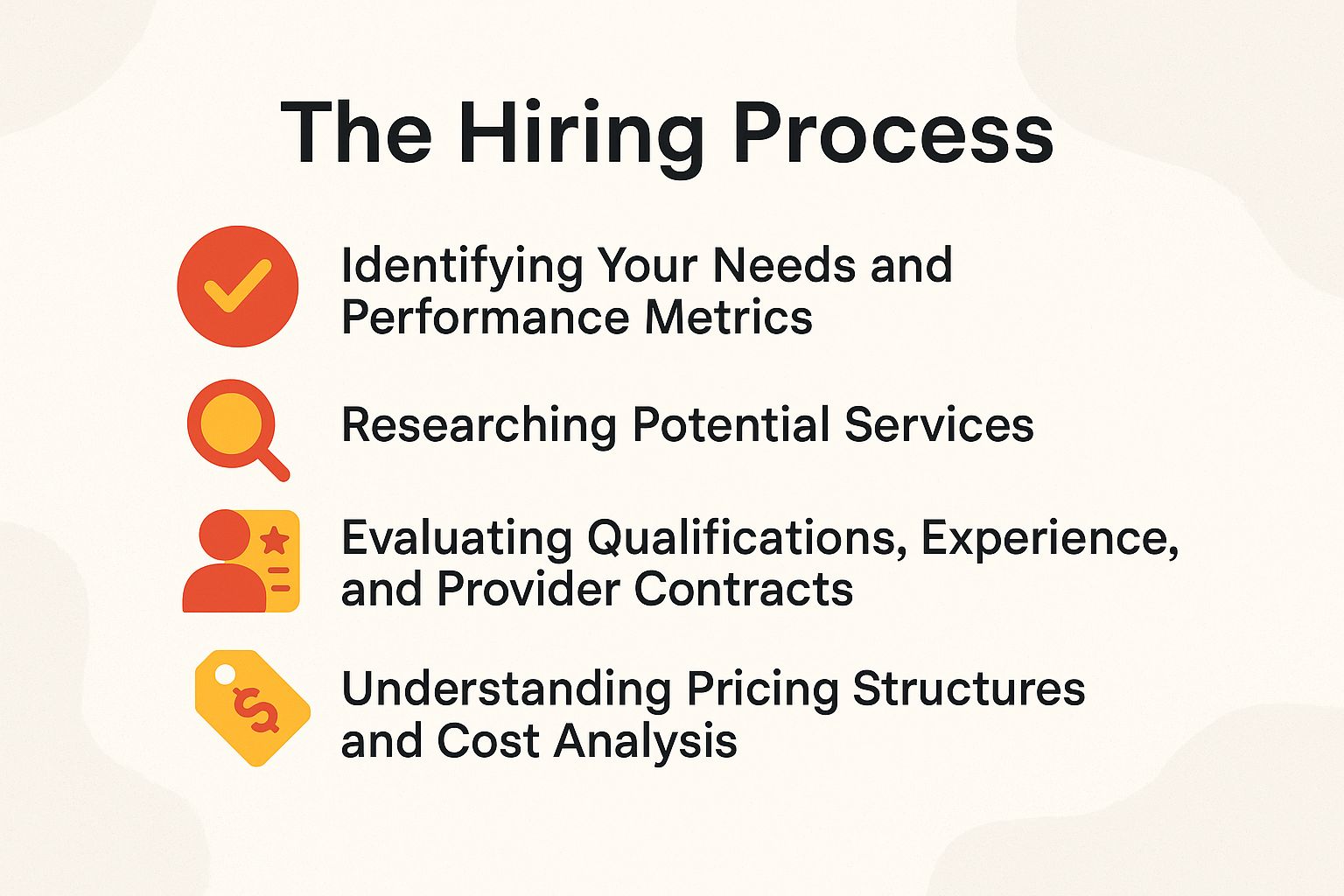
Choosing a company for medical billing services needs careful planning to make sure the chosen provider matches your business needs and follows regulations.
Identifying Your Needs and Performance Metrics
Start by assessing your specific requirements, including the volume of claims, types of medical services offered, and desired turnaround time for billing processes and patient collections.
Next, make a list to help with your choices. Consider aspects like:
- Claim Volume: Determine your average monthly claims and peak periods.
- Service Types: Identify whether you need coding, auditing, or consulting services.
- Turnaround Time: Assess how quickly you need claims processed, as this can vary based on service type.
- Software Compatibility: Make sure the software works well with your current systems.
Choose tools that match your objectives to make your tasks easier and work faster (our Medical Billing Software Buyer’s Guide 2025 provides valuable insights on selecting the right tools).
Researching Potential Services
Check out possible billing services by using websites like Clutch.co and Google Reviews to look at ratings and what customers have said about their billing cycles and operational efficiency.
Once you’ve gathered initial data, assess each service based on key criteria.
Look for their years of experience in the industry; a provider with over five years is often more reliable. Feedback from clients can show how good their customer service and reliability are.
Reach out for case studies or references to understand their success stories. Notice how quickly they respond when you ask questions; fast replies usually show they care about keeping clients happy.
Evaluating Qualifications, Experience, and Provider Contracts
Assess qualifications by reviewing each service’s credentials, including certifications like Certified Professional Biller (CPB) and years of experience in the healthcare sector.
Evaluate their familiarity with the specific coding systems relevant to your practice, such as ICD-10 and CPT. It’s important to ask about their experience with specific medical areas because this can greatly lower billing mistakes.
Ask for references from other healthcare providers they’ve worked with to gauge satisfaction. Make sure they use the latest software tools for efficiency, like AdvancedMD or Kareo, which simplify the billing process and help maintain accuracy. To delve deeper into the best practices and considerations, our comprehensive guide on choosing the right medical billing service offers valuable insights.
Examining Pricing Models and Cost Breakdown
Billing service pricing can range from 4% to 10% of collected revenue, depending on factors like service complexity and claim volume.
When reviewing choices, pay attention to important differences in how prices are set.
For instance, BillingPro charges a flat fee of $300 monthly, regardless of collection size, appealing to high-volume clients. ClaimEase uses a percentage model that starts at 6% for fewer claims and rises to 10% as more claims are made, making it a suitable choice for smaller services.
Meanwhile, RevenueCollect provides a hybrid approach-5% with a minimum fee of $200, striking a balance between fixed and variable costs.
Choose a service aligned with your business’s cash flow for optimal financial efficiency.
Onboarding Process

A good onboarding process makes sure that your medical billing service knows your workflows, systems, and expectations for an easy switch.
Initial Consultation and Client Onboarding
The initial consultation should focus on discussing your organization’s goals, current billing practices, and any challenges faced to tailor the service to your needs.
During the consultation, dive into specific pain points such as cash flow issues or inefficient invoicing processes.
Set clear expectations for outcomes, like reduced billing errors, improved coding accuracy, or faster payment cycles.
Establish key performance indicators (KPIs) to measure success, such as the percentage of on-time payments or reduction in billing disputes.
Programs such as QuickBooks or FreshBooks are recommended for easy invoicing.
By aligning on these details, you’ll create a customized service plan that addresses your organization’s unique demands.
Gathering Necessary Documentation and Ensuring Data Security
Collect all necessary papers, including patient information, service agreements, and previous billing records for financial reviews, to make sure everything is fully arranged.
To simplify the process of starting with us, group all documents into computer folders based on their kind, like ‘Patient Info’ and ‘Billing Records.’
Use secure methods for data sharing, like encrypted email via ProtonMail or cloud storage with Google Drive, setting sharing permissions to restrict access.
Consider utilizing a document management tool like DocuSign for obtaining e-signatures on agreements. Ensuring compliance with HIPAA guidelines is essential, so always encrypt sensitive files before sharing to safeguard patient information.
Setting Up Software, Systems, and Technology Integration
Make sure the billing software works smoothly with your electronic health records (EHR) system to improve data accuracy and make processes more efficient.
To accomplish this, focus on software such as AdvancedMD and Kareo to improve the billing process and connect EHR systems.
AdvancedMD offers effective EHR and billing connections, simplifying claim submissions and reducing errors. Kareo emphasizes easy use and fast installation, which is great for small medical offices.
During installation, match your billing codes with your EHR data to keep things consistent. Regular training sessions for staff will help them understand the system, improving their work speed.
Consider scheduling software updates bi-annually to keep your systems running smoothly and securely, ensuring HIPAA compliance.
Data Entry and Claim Submission
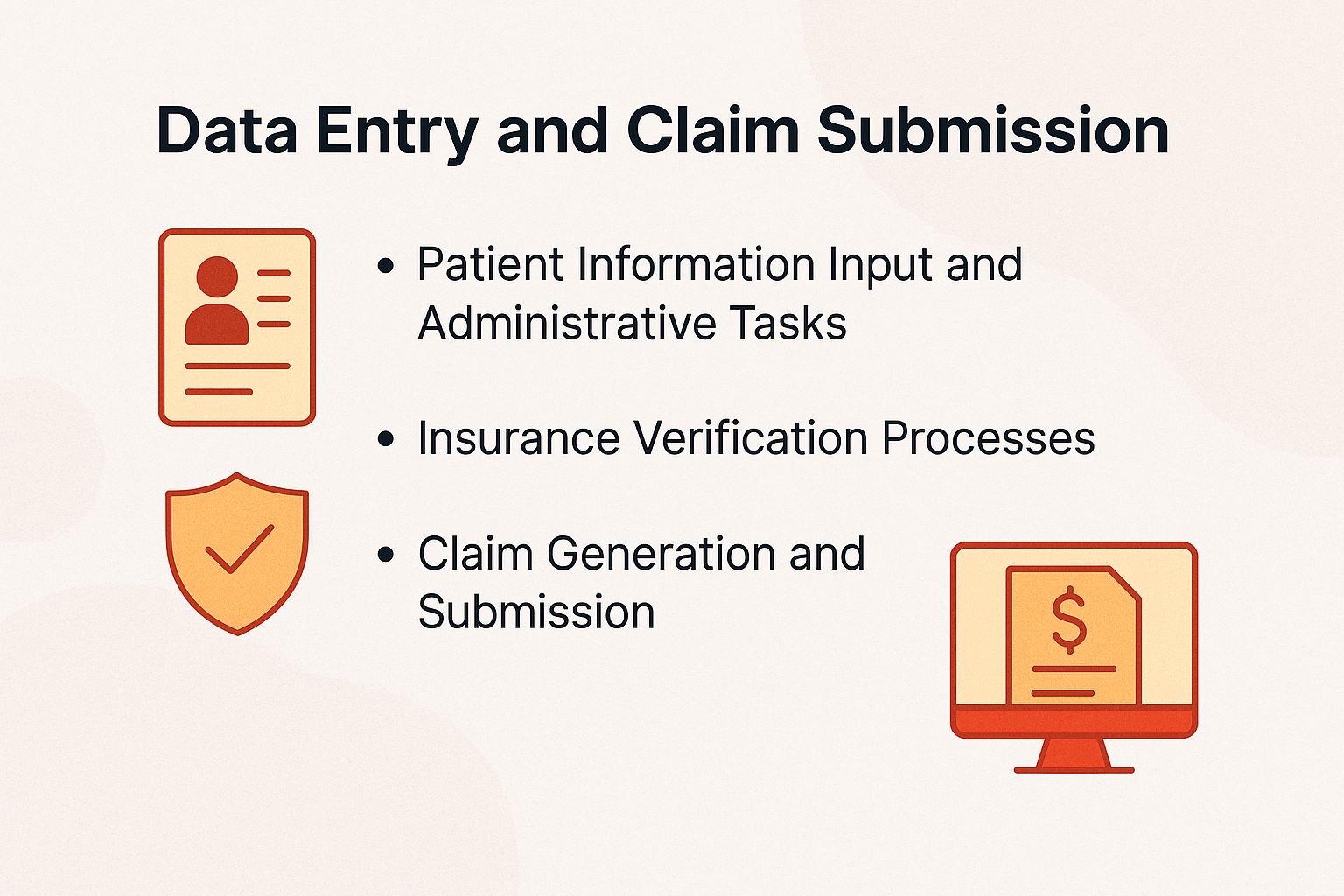
It’s important for healthcare providers to enter data correctly and submit claims quickly to receive timely payment for their services.
Patient Information Input and Administrative Tasks
Enter patient details correctly into the billing system to avoid delays in processing claims and follow rules.
- Begin by collecting all necessary documents, such as insurance cards and identification.
- Double-check the spelling of names, dates of birth, and policy numbers before entry.
- Use verification tools such as an insurance eligibility checker, if offered, to verify coverage information.
- After inputting data, review summaries for accuracy-this includes cross-referencing with what’s on file.
- Implement a routine audit process, reviewing entries monthly to spot recurring errors.
Regular checks will lower the number of denials and make billing much smoother, improving reimbursement processes.
Insurance Verification Processes
Implement insurance verification processes to confirm patient coverage before service delivery, reducing the risk of denied claims and enhancing payer relationships.
Start by using an Eligibility Verification Service (EVS), like Availity or Change Healthcare, to make the process easier. Typically, these services allow you to check patient benefits within minutes.
Set a protocol to verify coverage at least 48 hours prior to appointments. Train staff to gather essential information like patient ID and insurance details upfront, ensuring accuracy.
Maintain regular communication with payers to stay updated on any changes in coverage policies that may affect your practice.
Claim Generation and Submission
Use billing software to create and send insurance claims, making your medical practice’s financial management more accurate and faster, and reducing healthcare expenses.
- Start by choosing a trustworthy billing software like Optum360, which handles claims automatically and lowers mistakes.
- To make sure your claims have no mistakes, use a checklist to check patient information and insurance details before sending them in.
- Use tools like instant eligibility verification and automatic follow-ups for rejected claims.
- Regular training programs for your staff are necessary to get them comfortable with system updates and best practices. Handle claims within 24 to 48 hours to keep cash flow steady.
Follow-Up and Denial Management for Claims Processing
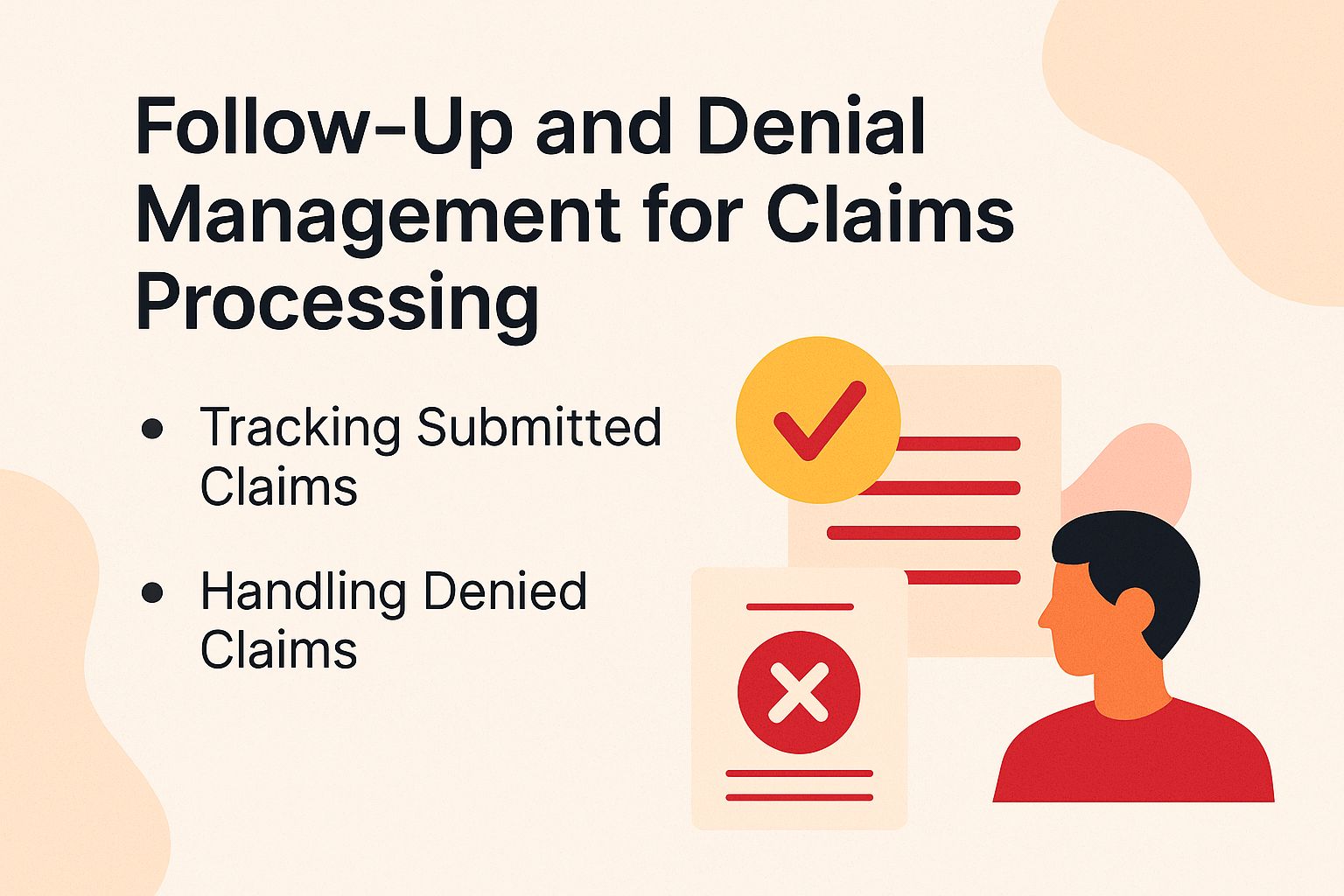
Proper follow-up and handling of denied claims are important for increasing income and reducing the effect of denied claims on your practice’s money.
Tracking Submitted Claims
Create an effective system to monitor the status of claims you have sent in, and promptly follow up on any amounts that haven’t been paid.
- Start by using claims tracking software like ClaimControl or TrackerPro, which send automatic alerts for each claim’s status. Set clear timelines for follow-ups-typically within a week of submission.
Regularly audit your claim logs to identify patterns; this helps pinpoint any recurring issues in specific areas and aids in billing audits.
Maintain a centralized database where all claims are recorded.
This will make communication with stakeholders easier and improve accountability by providing simple access to the history of each claim.
Handling Denied Claims
- Make a detailed plan for handling billing disputes. Find out why claims were denied and resubmit accurate claims quickly.
- Start by categorizing the denial reasons using the specific denial codes provided in the claim response. This will help identify whether issues stem from incorrect information, lack of coverage, or other factors.
- Next, gather necessary documents, such as patient records or prior authorizations, to support your appeal.
- Using templates for appeal letters makes the process easier; they help you save time and keep your letters uniform.
- Check the progress of your resubmissions often and set up steps to handle claims quickly.
Compliance and Regulations
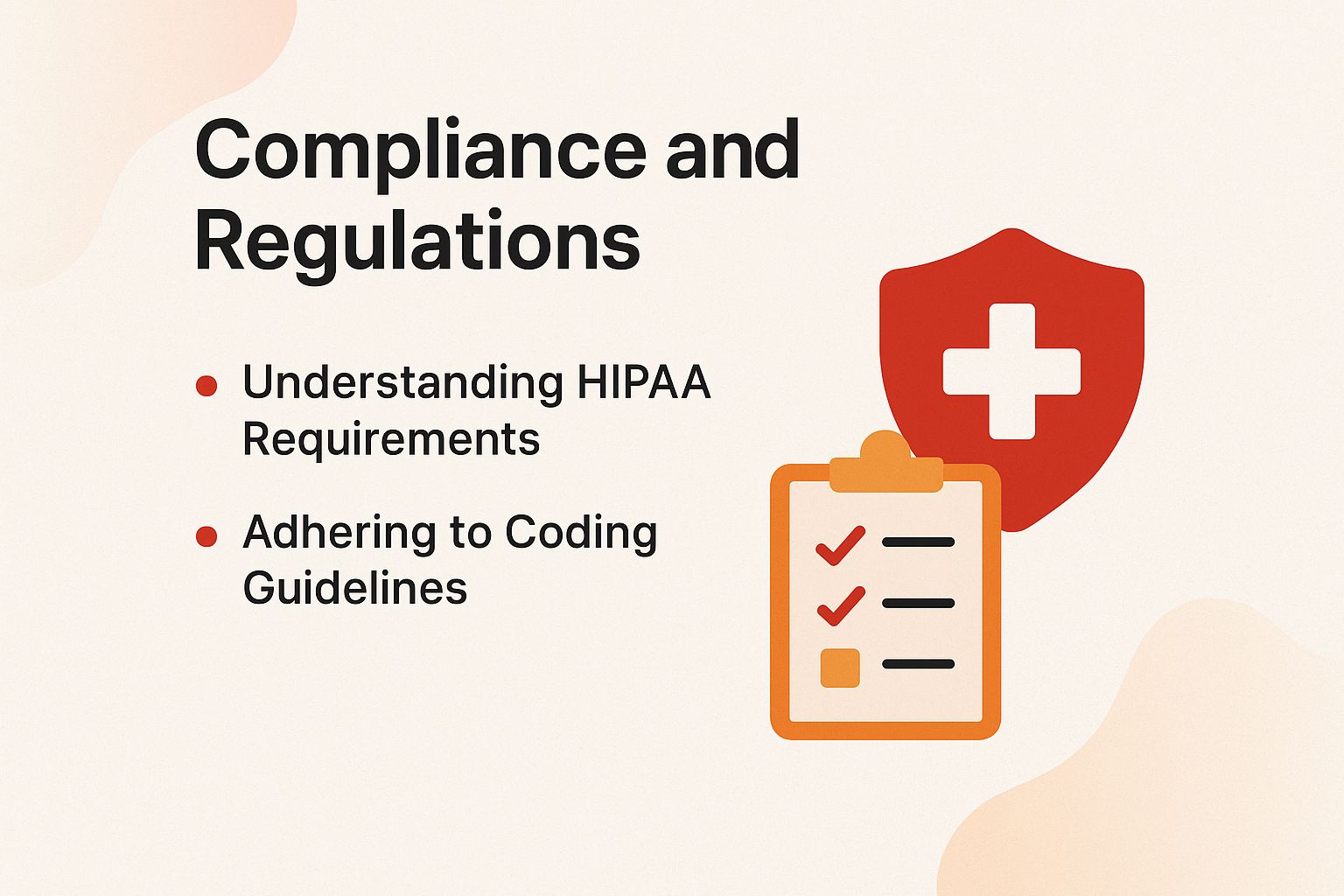
Following healthcare rules is essential for billing services because failing to do so can result in heavy fines and impact income.
Understanding HIPAA Requirements
Knowing HIPAA rules makes sure that patient details are handled correctly, protecting against data leaks and keeping trust.
To comply with HIPAA regulations in billing practices, organizations must prioritize proper training and secure systems. Related insight: Is Your Medical Billing Service Secure? Key Features to Look For
- Begin with employee training programs focused on privacy, ensuring staff understands how to handle Protected Health Information (PHI).
- Use secure electronic billing systems like Kareo or AdvancedMD, which include encryption, EHR integration, and control over who can access the information.
- Regularly perform checks to find possible weaknesses in your actions.
- Encourage a culture of compliance by having open discussions about the importance of HIPAA regulations, highlighting real-world consequences of non-compliance, which can include hefty fines and loss of patient trust.
Adhering to Coding Guidelines
Following coding rules like ICD-10 and CPT is important for accurate billing and reducing the risk of claims being rejected.
To stay current, regularly engage with resources like the American Academy of Professional Coders (AAPC). They provide many online courses and certification programs that help you improve your skills.
For example, earning the Certified Professional Coder (CPC) certification can greatly increase your knowledge of coding rules. Subscribing to AAPC’s professional journals or attending their annual conferences keeps you informed about industry changes.
By dedicating a few hours each month for training, you remain knowledgeable and comply with new regulations.
Reporting and Analytics

Reporting and analytics are important for figuring out billing performance and finding areas to improve within your practice’s revenue cycle.
Performance Metrics
Establish key performance metrics such as days in accounts receivable, claim denial rates, and collections as a percentage of charges to evaluate billing effectiveness.
To effectively track your billing performance, consider monitoring these metrics monthly.
Start by keeping track of how long accounts receivable are unpaid. Strive for 30 days to encourage fast cash movement. Aim for a claim denial rate under 5%, pinpointing issues that may require staff training or improved processes.
Tracking collections as a percentage of charges should ideally be above 95%, indicating efficient billing and improved revenue management.
Regular updates of these metrics help spot patterns and support ongoing progress in managing your revenue cycle.
Financial Reporting
Regular financial reporting is essential for evaluating the condition of your business and helps with planning budgets and predicting upcoming earnings.
To maintain accurate financial records, use tools like QuickBooks to track expenses and handle invoices. It simplifies data entry and provides detailed reports.
Consider integrating Excel for custom financial modeling or forecasts, allowing you to analyze trends over time.
Regularly scheduled financial reports-monthly or quarterly-should include:
- Profit and loss statements
- Balance sheets
- Cash flow statements
These reports enable you to make informed decisions about your practice’s financial directions and adjustments.
About the Author
I’m Amanda Anderson, a Stanford University graduate with a Bachelor of Corporate Communications and the owner of a successful medical billing company in Connecticut. With 12 years of experience in revenue cycle management and billing compliance, I help providers get paid faster and more efficiently through modern billing strategies and smarter technology. As a writer and editor for Medical Billing Service Review, I share insights to help healthcare professionals navigate billing with confidence.
Author: Mike Cynar
Mike Cynar brings buyers and sellers together by producing reviews and creating non biased webpages allowing users to share their experiences on various products and services. He and his staff write informative articles related to the medical field, legal, and other small business industries.

Leave a Reply